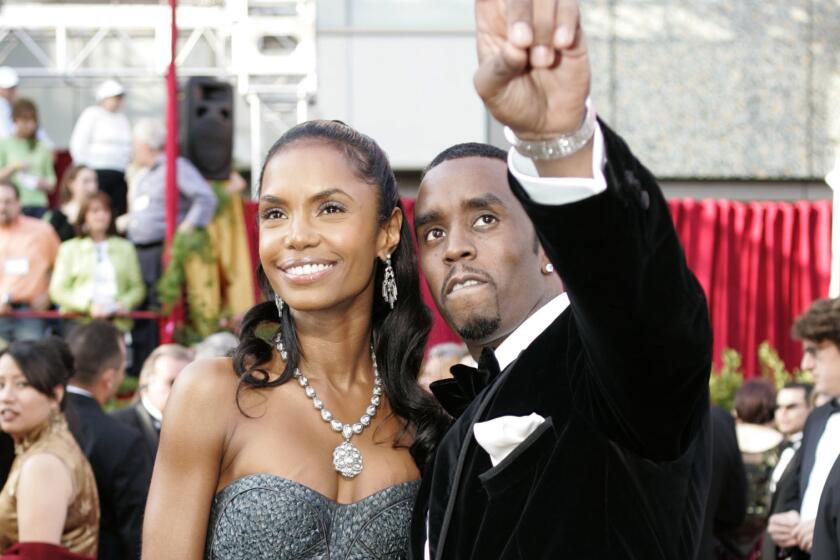Book Reviews : Exploring the Surreal, Odd Extremes of Entertainment
Learned Pigs and Fireproof Women by Ricky Jay (Villard: $29.95, illustrated)
“Learned Pigs and Fireproof Women,” one of the oddest histories of show business ever written, is an entertaining book about genuine theatrical originals written by a man who is, himself, something of an original, having gained fame from his unusual act of throwing playing cards, knocking the heads off toy animals, cigarettes out of volunteers’ mouths, and embedding the cards in a watermelon.
Ricky Jay, who in one publicity photograph is posed in bush outfit and pith helmet against a wall festooned with the heads of African animals that he has presumably felled with deadly accurate card throwing, is featured in the “Guinness Book of World Records” as having thrown a playing card farther and with greater accuracy than any person, so inclined, in history.
Jay also is a popular lecturer on the college circuit on conjuring and related arts, an accomplished sleight-of-hand artist frequently appearing on network television, and curator of the Mulholland Library in Los Angeles, one of the world’s finest repositories of works on the art of the magician.
Astonishing and Funny
In this book, his second (the first was “Cards as Weapons”), Jay documents, with obvious fascination, amusement and delight, many of the odd acts and equally odd performers who have interested, and, perhaps, obsessed him from his research into the checkered history of variety entertainment. For those who think that show business is exclusively the domain of actors, singers, comedians and dancers, with an occasional juggler, magician, acrobatic or animal act thrown in for variety, this book should be a revelation. Jay has studied the bizarre and often surreal extremes of entertainment, and the results of his scholarship is a book that is both astonishing and genuinely funny.
Some of the theatrical personalities Jay describes are genuine accidents of nature, such as the amazing Matthew Buchinger, “The Wonderful Little Man of Nuremberg” and one of the true wonders of the early 18th Century. Buchinger, who was born without feet or arms, and who never grew taller than 29 inches, played more than half a dozen musical instruments, composed music and was an excellent marksman who performed a trick-shot act, an amazing conjurer, a graphic artist and calligrapher of uncommon skill, and, in the 66 years of his busy life, the father of 14 children.
Other subjects in the book, like Blind Tom, the son of slaves and, by all reports, an imbecile but with prodigious and totally unexplainable musical talents, were classic “idiot savants” whose remarkable abilities were exploited by theatrical impresarios for the entertainment of the public.
Theatrical Characters
Perhaps the most fascinating characters in Jay’s gallery of mental marvels, pig-faced women, water spouters, daredevils and swallowers of snakes, swords and frogs, are those theatrical characters who were not forced into their calling by some whim of nature but who deliberately created themselves in some strange image of their own devising: Harry Kahne, the Multiple Mental Marvel, who could write five words simultaneously with pieces of chalk held in each hand, each foot, and in his mouth; LaRoche, who by changing his body position while sealed inside a two-foot-in-diameter metal sphere, caused it to ascend a 24-foot-high spiral track, proving that man, if he put his mind to it, could accomplish the nearly impossible; Walford Bodie, the self-styled “Doctor” who allegedly cured spectators of their various afflictions by high-voltage electricity (which he termed the “Bodic Force”).
Perhaps the most original variety act belongs to equestrian and bee trainer Daniel Wildman, who, in 1772, rode around a circus ring standing on his horse while a swarm of bees covered his face. Upon the firing of a pistol, half the bees returned to the hive while the others moved to a nearby table.
“Learned Pigs and Fireproof Women” is a work of true scholarship, written with wit and style. Reading about these bizarre theatrical presentations and their eccentric practitioners may be at least as fascinating, and, in some cases, more palatable than witnessing the acts themselves.
More to Read
Sign up for our Book Club newsletter
Get the latest news, events and more from the Los Angeles Times Book Club, and help us get L.A. reading and talking.
You may occasionally receive promotional content from the Los Angeles Times.








